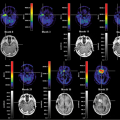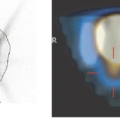PET and PET-CT Imaging Protocols
Thomas F. Hany
Standardization of PET and PET-CT imaging protocols is beneficial for optimizing image quality as well as workflow in a PET center. Fluorine 18 [18F]fluorodeoxyglucose (FDG) is used as a metabolic marker mainly in oncology but also in cardiology, neurology, and inflammation imaging, whereas nitrogen 13 [13N]ammonia and oxygen 15 [15O]H2O are used for perfusion measurement in neurology and cardiology PET imaging. For every single tracer, specific data acquisition protocols have to be used. Essentially, all PET imaging can be performed on PET alone scanners, but the introduction of PET-CT scanners does allow for faster patient throughput. With the availability of diagnostic CT imaging in a single machine, oral and intravenous contrast agents can be added and can make protocols more complex. In FDG-PET-CT, it is useful to opacify bowel with dilute contrast agent. A CT scan with the application of intravenous contrast agent is best done after the PET emission scan to avoid image artifacts. Once a PET-CT has been obtained, it is easy to correlate its information with other anatomic cross-sectional imaging documents available from prior studies or studies acquired after PET-CT.
Introduction
Since only coincidence events of photons generated by annihilation are detected, different positron-emitting radiopharmaceuticals can be used in the same PET scanner. In a sense, each radiopharmaceutical generates a new type of imaging study. Thus imaging protocols are strongly dependant on the radiopharmaceutical used. The most frequently used metabolic marker is fluorine 18 [18F]fluorodeoxyglucose (FDG), whereas nitrogen 13 [13N]ammonia and oxygen 15 [15O]H2O are the routine radiopharmaceuticals for perfusion measurement (1,2,3,4). For each application, specific patient preparation, patient positioning, data acquisition, and reconstruction algorithms are needed to obtain optimum image quality on PET and PET-CT scanners. In this chapter, we describe the detailed practical workflow in PET imaging for these three PET tracers, which dominate clinical routine on most PET scanners. Further, practical issues regarding the use of oral as well as intravenous contrast agents for PET-CT imaging are discussed.
Quality Assurance and Quality Control
Quality control is mandatory for reliable data acquisition in PET imaging (5). The accuracy of PET source data is based on optimal tuning of the PET scanner, which is obtained by continuous quality control. Quality control includes the control of the following system characteristics: function control of the scintillation detectors (blank scan), photo-multipliers (updating of gain calibration), and a check of the coincidence timing correction (CTC). For system sensitivity measurements of each line of response (line between any two detectors in the PET ring detector; see Chapter 3), a normalization has to be performed, which is used to correct the emission scanning data (normalization). Furthermore, a standard dose of radiotracer is measured during several minutes in a standard phantom (2-D and 3-D well counter correction) in order to ascertain proper calibration of quantitative values of PET radiotracer activity measured in the 2-D and 3-D modes. The daily quality control in the morning includes only the blank scan.
The weekly quality control includes a extended blank scan and updated gain calibration and CTC. Bimonthly and after major maintenance work, a 2-D and 3-D well counter calibration is necessary. Overall, the above-mentioned procedures do not represent the standard of care, and quality control and quality assurance procedures have to be performed in compliance with the individual manufacturer of the PET or PET-CT machine.
The weekly quality control includes a extended blank scan and updated gain calibration and CTC. Bimonthly and after major maintenance work, a 2-D and 3-D well counter calibration is necessary. Overall, the above-mentioned procedures do not represent the standard of care, and quality control and quality assurance procedures have to be performed in compliance with the individual manufacturer of the PET or PET-CT machine.
Patient Scheduling
Optimization of patient throughput in a PET center depends critically on the PET radiopharmaceuticals and the PET protocols used. Due to the relatively long production time and the half-life of FDG, which permits scanning for approximately half a day, most PET centers use their cyclotron or radiopharmacy unit for FDG production early in the morning. Consequently, PET scanners with on-site cyclotrons and satellite PET centers will receive FDG for scanning in the morning. Additional FDG scanning can be done if an end-of-morning second FDG production is available. Otherwise, and in PET centers with cyclotrons, imaging with tracers like [13N]ammonia and [15O]H2O, which have to be produced for individual patients, is scheduled in the afternoon. For proper patient scheduling, knowledge of the average scan times is helpful, and the use of ad hoc complex FDG protocols should be avoided.
General Considerations Regarding Patient Preparation for FDG Applications
Prior to FDG Injection
Patients have to fast for at least 4 hours prior to the FDG injection. There are no restrictions for intake of prescribed daily medications. Note that many intravenous infusions contain glucose; they have to be replaced for that amount of time by an infusion free of glucose. A pre-FDG-injection blood glucose measurement should be performed in all patients to ensure patient fasting status as well as to detect patients with elevated blood glucose levels due to unknown causes or possibly tumor-related diabetes mellitus. Based on our experience, patients with blood glucose level above 160 to 200 mg/dL should be rescheduled for another day.
At FDG Injection
As patients should be injected in a quiet room and in a supine or reclining relaxed position, FDG injection is done in so-called uptake rooms. A single uptake room is sufficient if the PET scan lasts longer than the minimum uptake time of approximately 40 to 60 minutes necessary for FDG. If scans are shorter than this time, which is typically the case in brain FDG studies or FDG-PET-CT exams, the availability of additional uptake rooms is needed, because more than one patient will be awaiting scanning at any point in time. For the injection, intravenous access is obtained via a 20-gauge indwelling catheter. Function control of the intravenous access is strongly recommended to prevent paravenous injection of the radiotracer. Note that aspiration of blood into the FDG-containing syringe should not occur, as the formation of FDG-containing microemboli lodging in the lungs has been reported (6). Sufficient saline flushing of the syringe containing the activity and the catheter after injection is necessary for complete application of the dose.
In adult oncologic patients, a standard dose of 370 MBq (10 mCi) is injected independent of patient weight in our center. Other centers use doses up to 740 MBq (20 mCi) to speed up data acquisition and maintain image quality. In our experience, this is not necessary, because even with the lower dose high-quality scans are obtained in overall imaging times of less than 40 minutes. Furthermore, radiation protection issues should not be ignored (see Chapter 9). For dedicated brain imaging, a dose of 200 MBq is sufficient.
Note that pre- and postinjection dose measurements of the syringe in a dose calibrator are needed to reconstruct attenuation-corrected, semiquantitative PET images and make standardized uptake values (SUVs) available (see Chapter 11). In addition, meticulous measurements of the other factors required for this calculation (i.e., patient weight, patient height, injected dose, time of injection, and time of data acquisition) are mandatory in order to obtain reliable results (7). PET scans allowing SUV measurements can now be easily reconstructed with commercially available software, and their calculation as standard imaging documents is highly recommended for PET-CT imaging.
After the Injection
Patients are required to rest in the darkened, quiet uptake room with eyes closed for at least 20 minutes. The patient should be asked to refrain as much as possible from speaking. When space limitations are critical, it may be possible to remove the patient from the uptake room after 20 minutes and keep him or her in the waiting room for the rest of the uptake phase. Just prior to imaging, the patient is asked to void as completely as possible in order to minimize PET image artifacts in the pelvic region, which can stem from high bladder activity. For PET-alone imaging in a patient with suspected pelvic disease (cervix or uterus cancer, involvement of the bladder), catheterization of the bladder with continuous saline flushing can be useful. However, this procedure is not needed in FDG-PET-CT imaging. For patient imaging, no premedication is given routinely. However, some institutions prefer the application of diazepam for the reduction of muscular uptake and/or furosemide for artifact reduction due to high activity in the renal pelvis (8,9).
Whole- and Partial-Body FDG-PET and FDG-PET-CT Imaging Protocols
General
Whole-body FDG-PET imaging in our institution is defined as covering the patient from head to toe. Partial-body scans include multiple contiguous axial field of views (AFOVs) typically covering the patient from the head to the pelvic floor. The position of the table cradle defines the body area of the patient to be scanned. Thus, with an AFOV of 15 cm, repeated movement of the table cradle by this distance will result in a contiguous series of sections of the patient; this is the way in which whole- or partial-body scans are obtained. Six cradle positions covering approximately 90 cm of the patient’s body are usually sufficient to obtain a tomographic PET data set covering the patient from head to pelvic floor in PET and PET-CT imaging.
Patient Positioning: PET Alone
For PET-alone imaging, positioning includes placement of the patient in a supine position with the head in a headholder to restrict movement, comfortable support of the legs, and fixation of the arms alongside of the body to restrain them from movement.
Patient Positioning: PET-CT
For PET-CT imaging, as in diagnostic CT examinations, the patient has to remove all removable metallic parts, such as rings and artificial dentures, prior to scanning. As in PET-alone imaging, the patient is positioned supine and head first on the table, except when PET-CT data are used for radiation therapy planning (see Chapter 57). For optimal coregistration in the head region, the head is placed in a headholder, but, otherwise, comfortable positioning of the patient is achieved using cushions and fixing stripes. Positioning of the arms is strongly dependent upon the suspected diagnosis. For ENT tumor or other head-and-neck imaging, the arms of the patient should be alongside the body to prevent beam-hardening artifacts at the level of the neck. For all other oncology imaging procedures, the arms are placed above the head whenever possible. Some groups advocate splitting data acquisition into two parts, one covering the head and neck region with the arms down, the other the torso region with the arms up. Positioning of a patient in the radiation treatment position can also be performed without restraints (see Chapter 57).
Oral Contrast Application in FDG-PET-CT Imaging
In FDG-PET-CT imaging, oral contrast (e.g., Micropaque Scanner, Guerbet AG, Aulnay-sous-Bois, France) is administered routinely up to 30 minutes prior to FDG injection, since adequate distribution of contrast in the bowel is achieved typically after 60 minutes. The application of barium sulfate containing oral contrast agents is a safe procedure and mostly used for outpatient imaging. In postoperative patients, iodinated oral contrast agents (e.g., Gastrografin, Schering AG, Berlin, Germany) are used for safety reasons, since these agents do not induce peritonitis when leaking into the peritoneum. The volume of oral contrast agent given (1 liter of solution) is identical to that given in diagnostic CT imaging. Just prior to patient positioning on the table, an additional volume of 1.5 dL oral contrast is given to optimize the contrast between gastric and duodenal structures and their surroundings (3). A contrast enema is not given routinely. No significant artifacts are seen in PET emission imaging due to prior application of oral contrast agent (10,11) (see Chapter 7).
Emission Data Acquisition: PET and PET-CT
Stay updated, free articles. Join our Telegram channel

Full access? Get Clinical Tree







